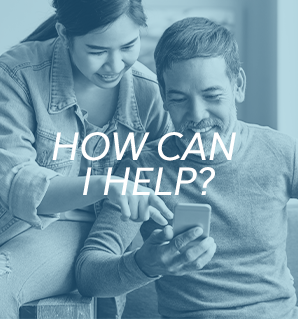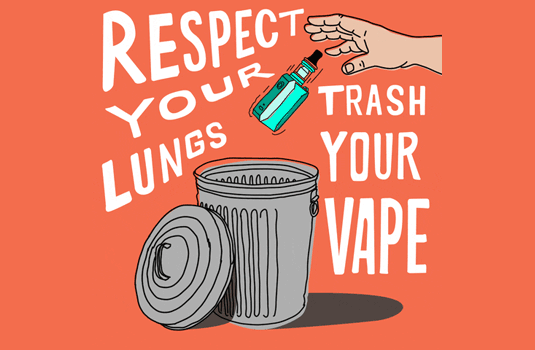Helping Friends & Family Quit Tobacco
Quitting cigarettes, vapes, or smokeless tobacco is tough. People who quit say that support from friends & family was important to their success. This guide is based on advice from people who have quit and the friends and family members who helped them. Ultimately, only your friend or family member can make the decision to quit, but you can certainly help them by using the information from this guide.

Step 1: Learn
QUITTING IS TOUGH
To help someone you care about quit, it’s important that you first understand the many reasons they may struggle to quit.
They may have mixed feelings about quitting.
They know smoking, vaping, or using smokeless tobacco is bad for them, but it also gives them something they like. Whatever they get out of it keeps them hooked.
Using tobacco is a habit.
Many people smoke, vape or chew at the same time every day, for the same reasons. It becomes automatic. Quitting can disrupt the daily routine. Some people go back to using to feel normal again.
Using tobacco fills a need.
Many people smoke, vape or chew to help them get through the pressures of daily life. They may come to believe that it’s the only way to cope. People who have used for a while, often see their habit as a long-time “friend.” They may have strong feelings of loss when they try to quit.
They may be dependent on nicotine.
Their bodies may crave nicotine after quitting. Withdrawal symptoms are normal. They go away on their own, usually in a week or two.
Some people start using again to get rid of withdrawal symptoms. Keep in mind that thousands of people quit each year, despite the mixed feelings, the habit, the need and the nicotine. These are common withdrawal symptoms someone may experience.
| Dizziness | Depression | Trouble Thinking | Coughing | Restlessness |
|---|---|---|---|---|
| Headaches | Hunger | Tiredness | Irritability | Trouble Sleeping |
How People Quit
It’s rare for someone to wake up one day and quit for good. More often, people take small steps toward kicking their habit. Keep these things in mind.
Quitting happens over time.
+
Most people try many times before quitting entirely. With every try, they learn more about how to quit for good. The more times a person tries to quit, the closer they are to succeeding for life.
Motivation and planning are important.
+
People can quit even without strong willpower. The real keys to success are motivation (finding a strong reason to quit) and planning.
Slips and relapses are normal.
+
People often slip (use, but get back on track with quitting) or relapse (start using regularly again). This is not a sign of weakness. It may just mean that the person needs to do more planning.
It takes a while for people to change their thinking.
+
When they first quit, they still think like tobacco-users. Every day, they have to decide whether or not to smoke, vape or chew. People who successfully quit decide once and for all that they will not do it again, no matter what. We have found that people can be very successful if they decide once and for all.
Step 2: Ask
1. How ready are you to quit?
If the person is not ready, don’t push. But that doesn’t mean you give up. They have to make the decision for themselves, but you can keep asking questions to show you care.
2. What concerns you the most about quitting?
Listen without judging. Show that you care and that you really want to know.
3. What can I do to help?
If you can, give exactly the kind of help they ask for. More important than doing any one special thing is showing understanding about the challenges of quitting.
Tip Cards
Important tips on how to talk about quitting with the smoker in your life.

Smokers can get discouraged when they try to quit and “fail.” Knowing YOU think they can do it can give them the courage to try again.

Most smokers don’t quit on the first try. Your support will make them more likely to try again.

Quitting is easier with help. Ask the smoker what they find most helpful.
Step 3: Support
1. Help with planning.
- Check out our Quit Guides & Interactive Quit Plans for guidance.
- Help your family member or friend find their motivation to quit. People who have strong reasons are more successful.
- Ask what times each day or what situations they think will be most difficult without cigarettes, vapes or chew.
- Help them think through what they can do instead of smoking, vaping or dipping.
2. Make your environment tobacco-free.
- If you smoke, vape, or chew, try quitting together.
- Encourage a ban in your home and car. It makes quitting easier and protects everyone from secondhand exposure.
- Provide substitutes, like healthy snacks or gum.
3. Encourage & participate in tobacco-free activities.
- Suggest ideas like taking a walk or going to places (movies, malls, restaurants) where smoking or vaping is not allowed.
- Avoid parties and bars, as alcohol is often a trigger.
4. Try not to nag.
- Think about your relationship with the person and how you may affect their habit and their quitting. If you’ve nagged them or argued with them about quitting in the past, re-think your approach.
- Complaints and pressure only lead to tension and arguments.
- Be patient and positive. Offer consistent encouragement, like “You can do it!” or “We can do it together.”
5. Be patient with mood swings.
- They may be grouchy, nervous, or forgetful at first.
- Keep in mind that these changes in mood won’t last.
6. Suggest they connect with a Quit Coach.
Step 4: Accept
Accept that there's a limit to what you can do. You may need to give your friend or family member some space. Say something like,
“I know that quitting is your decision, not mine.”
“I respect your right to decide when you're ready.”
If you can't help nagging, share your concern at the same time. You might say,
“I care about you.”
“I want you to have a healthy future.”
Show understanding about slips and relapses.
Praise every effort your friend or family member makes. Say, “Even a short try is a success.”
Remember:
You may not get the results you’re looking for the first time you talk with someone about quitting. It may take several tries, but don’t give up!


